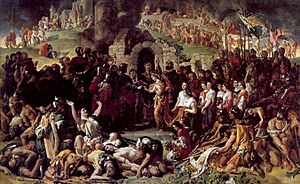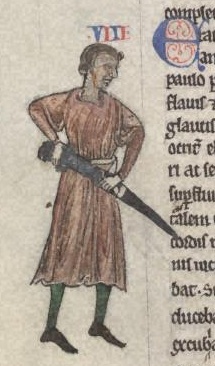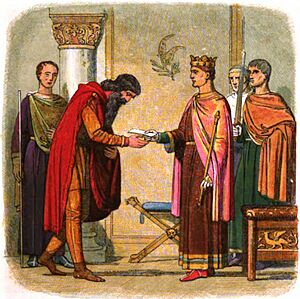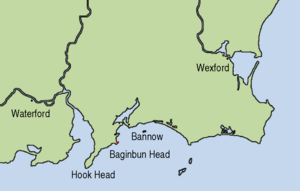Anglo-Norman invasion of Ireland facts for kids

The Anglo-Norman invasion of Ireland happened in the late 1100s. During this time, people called Anglo-Normans slowly took over large parts of Ireland. The kings of England then said they ruled these lands. This was supposedly allowed by a special letter from the Pope called Laudabiliter.
Back then, Gaelic Ireland had many different kingdoms. One powerful king, called the High King, was in charge of most of the others. The Norman invasion changed Ireland's history forever. It was the start of over 800 years of English and later British rule and control in Ireland.
In May 1169, Anglo-Norman soldiers arrived in Ireland. They came because Diarmait mac Murchada (Dermot MacMurragh), the king of Leinster, asked for their help. He had lost his kingdom and wanted it back. The Normans helped him get it back in just a few weeks. They also attacked nearby kingdoms. King Henry II of England approved this help. In return, Diarmait promised to be loyal to Henry and give land to the Normans.
In 1170, more Normans arrived. They were led by Richard "Strongbow" de Clare, who was the Earl of Pembroke. They captured important towns like Dublin and Waterford. Strongbow also married Diarmait's daughter, Aoífe. Diarmait died in May 1171. Strongbow then claimed Leinster, as Diarmait had promised it to him.
The High King, Ruaidrí Ua Conchobair (Rory O'Conor), led many Irish kingdoms to fight back. They attacked Dublin, and also Waterford and Wexford. But the Normans managed to keep most of their land.
In October 1171, King Henry II came to Ireland with a big army. He wanted to control both the Anglo-Normans and the Irish kings. The Roman Catholic Church supported Henry. They wanted to fix some church rules in Ireland and also get taxes. At that time, Irish marriage rules were different from the main Church rules. Also, some church reforms had not fully happened in Ireland.
Henry let Strongbow keep Leinster as a special gift. He also said that the towns of Dublin, Wexford, and Waterford belonged to the English crown. Many Irish kings gave in to Henry. They probably hoped he would stop the Normans from taking more land. But Henry gave the kingdom of Meath, which was not yet conquered, to Hugh de Lacy. After Henry left in 1172, fighting between the Normans and Irish continued.
The Treaty of Windsor in 1175 said that Henry was the main ruler of the land the Normans had taken. It also said Ruaidrí was the main ruler of the rest of Ireland. Ruaidrí promised to be loyal to Henry. But the treaty soon broke down. Norman lords kept invading Irish kingdoms, and the Irish kept attacking the Normans.
In 1177, Henry changed his plan. He said his son John would be the "Lord of Ireland." This meant he claimed the whole island. He also told the Norman lords they could conquer more land. The land they held became known as the Lordship of Ireland. It was part of Henry's large Angevin Empire. The Normans won because they had better weapons and built castles. Also, the Irish kingdoms were not united, and the Church supported Henry.
Contents
Why the Invasion Happened
In the 1100s, Gaelic Ireland had many large kingdoms. Each of these had smaller kingdoms inside them. The High King was the most powerful. He received gifts from other kings but did not rule all of Ireland directly. However, Ireland shared a common culture and legal system. Five port towns – Dublin, Wexford, Waterford, Cork, and Limerick – were ruled by the Norse-Irish people.
The Normans had conquered England between 1066 and 1075. After this, Normans held all the important positions in England. Over the next few decades, Norman lords also conquered much of south Wales. They set up their own powerful areas there. Historian John Gillingham says that after conquering England, the new French-speaking rulers of England started to see their Celtic neighbours as less civilized.
Early Norman Interest in Ireland
It is believed that the Normans thought about conquering Ireland even before 1169. The Anglo-Saxon Chronicle says that if William the Conqueror had lived longer, he would have taken over Ireland. William's son, William II, also said he would gather all his ships to build a bridge to Ireland.
There were contacts between the Irish and Normans before the invasion. For example, a Norman lord named Arnulf de Montgomery was married to the daughter of Murtough O'Brien. O'Brien was a king in Ireland and also a High King.
In 1155, King Henry II of England thought about invading Ireland. He even planned to give it to his brother. Church leaders in England strongly supported this idea. But the plans did not happen, supposedly because Henry's mother, the Empress Matilda, was against it.
The Church's Role in the Invasion
Some English church leaders, especially Theobald, the Archbishop of Canterbury, wanted to control the Irish church. They wanted to make sure the Gregorian Reforms were fully followed in Ireland. Irish church leaders had already tried to make reforms. But it was hard to make these changes. They involved giving up old Irish customs that had been around for a very long time. These customs included ideas about marriage and how church lands were controlled.
In 1155, John of Salisbury, who worked for the Archbishop of Canterbury, spoke to Pope Adrian IV. He asked for Norman involvement in Ireland to reform its people. This led to a special letter from the Pope, called Laudabiliter. This letter supposedly gave Henry II the Pope's permission to get involved in Ireland, even by conquering it.
The First Landings in 1169
In 1166, Ruaidrí Ua Conchobair (Rory O'Connor) was recognized as the High King of Ireland. He led a group of kings, including Tigernán Ua Ruairc (Tiernan O'Rourke) of Bréifne. This group forced Diarmait mac Murchada (Dermot MacMurragh) out as king of Leinster. Diarmait refused to accept this. On August 1, he sailed from Ireland to Bristol with his daughter Aoife. He asked King Henry II for help to get his kingdom back.
Henry gave Diarmait permission to find soldiers. He also allowed his own people to help Diarmait. In return, Diarmait promised to be loyal to Henry. This deal would also help Henry use the Dublin fleet in his fights against the Welsh and Scots.
Several powerful Norman lords agreed to help Diarmait. These included Richard FitzGilbert de Clare (Strongbow), Robert FitzStephen, and Maurice FitzGerald. Diarmait promised Strongbow his daughter Aífe in marriage. He also promised Strongbow the kingship of Leinster after Diarmait's death. He promised Robert and Maurice the town of Wexford and nearby lands. Under Irish law, Diarmait did not have the right to make these promises.
On May 1, 1169, Robert FitzStephen and Maurice de Prendergast landed in Wexford. They had about 40 knights, 60 foot soldiers, and 360 archers. This group joined with about 500 men led by Diarmait. They started taking over Leinster. First, they attacked the seaport of Wexford, which gave up after two days. They then raided other parts of Leinster. They also attacked the nearby kingdom of Ossory.
High King Ruaidrí then led an army into Leinster to fight Diarmait and the Normans. An agreement was made: Diarmait was recognized as king of Leinster. In return, he had to accept Ruaidrí as his main ruler and send his foreign allies away. Diarmait gave his son as a hostage to ensure he would follow the agreement. However, Diarmait seemed to want to use his Norman allies to become High King himself. Soon after, Maurice FitzGerald arrived with more soldiers. Maurice and Diarmait marched north and attacked the area around Dublin.
Strongbow Arrives in 1170
In May 1170, Raymond FitzGerald landed in Wexford with some knights and archers. This was the first group for Strongbow's army. They planned to attack Waterford. Raymond's men took over an old fort and raided the area. A much larger Irish and Norse-Irish army then surrounded them. The Normans, though outnumbered, drove a large group of cattle into the enemy army. This caused chaos, and the Normans defeated their attackers. They killed many and captured 70. These captives were then executed.
On August 23, Strongbow landed with at least 200 knights and 1,000 soldiers. They joined Raymond's group and attacked Waterford. They broke through the walls, and there was fierce fighting. Many defenders were killed. Diarmait and the other Norman leaders then arrived in Waterford. Strongbow married Diarmait's daughter, Aífe, there.
The Normans and Diarmait decided to take Dublin. High King Ruaidrí set up a large army near Dublin to stop them. But the Normans and Diarmait went around them by going over the Wicklow Mountains. This forced Ruaidrí's army to change their plans.
When they reached Dublin, Diarmait started talking with its king, Ascall mac Ragnaill (Ascall MacRannall). On September 21, while talks were still happening, a group of Normans attacked the town and took it. Ascall and his followers escaped by ship. Strongbow and Diarmait then attacked Meath and Breffny, burning towns like Clonard and Kells. Because of these attacks, Ruaidrí executed three hostages, including Diarmait's son.
Diarmait died suddenly in May 1171. Strongbow then claimed Leinster, as Diarmait had promised it to him. However, Strongbow would not have been seen as Diarmait's rightful heir under Irish or English law. Diarmait had other family members. It is thought that Strongbow's claim was made to seem legal by saying Aífe was Diarmait's only true heir. Also, under Irish law, kingship was chosen, not passed down through marriage. Diarmait's son, Domnall Cáemánach, supported Strongbow. Strongbow gave Domnall power over the Irish people in most of Leinster.
Irish Fight Back in 1171
Soon after Diarmait died, the Anglo-Normans were attacked. Diarmait's brother, Murchad, became ruler of Diarmait's home area. He and other Leinster rulers fought against Strongbow. The Irish of Desmond also attacked Norman-held Waterford. At the same time, a Norse-Gaelic army tried to take back Dublin but was defeated. Their leader, Ascall, was captured and killed.
A large army, led by Ruaidrí, surrounded Dublin. It included soldiers from most Irish kingdoms. A Norse-Gaelic fleet also blocked Dublin bay. The Normans in Wexford sent their best soldiers to help Dublin. The remaining soldiers in Wexford were then attacked and forced out. They fled to a camp at Carrick, where they were surrounded. The siege of Dublin lasted for two months. The Irish army seemed to want to starve the city into giving up.
Strongbow and his leaders agreed to talk. Strongbow offered to recognize Ruaidrí as their main ruler if the Normans could keep what they had conquered. Ruaidrí said the Normans could only keep Dublin, Wexford, and Waterford. Strongbow refused. A group of Normans secretly left Dublin and made a surprise attack on Ruaidrí's camp. They killed hundreds of soldiers and took supplies. After this defeat, the Irish army left. Meanwhile, the Norman leader FitzStephen had given up to the Norse-Irish at Carrick. When they heard Strongbow was coming, they burned Wexford and left, taking FitzStephen as a hostage.
King Henry II Arrives in 1171
King Henry was worried that Strongbow would create his own independent kingdom in Ireland. This new kingdom could control the sea and cause problems for England. In early 1171, Henry told his subjects to return to England or lose their land. Strongbow reminded Henry that he had gone to Ireland with Henry's permission. He said everything he gained in Ireland was thanks to Henry. In July, Henry made Strongbow a "royal constable in Ireland."
By September 1171, Henry decided to lead a military trip to Ireland himself. He called Strongbow to meet him. On October 17, 1171, King Henry landed at Waterford with a large army. This was the first time an English king had come to Ireland. It marked the start of England's claim to rule Ireland. Henry led his army to Lismore and then to Cashel. He planned to hold a church meeting there. Henry then went to Dublin.
The Norman lords promised their loyalty to Henry. They gave him the land they had conquered. Henry let Strongbow keep Leinster as a special gift. He also said Dublin, Wexford, and Waterford belonged to the English crown. Fifteen Irish kings and chiefs gave in to Henry. They probably hoped he would stop the Normans from taking more land.
The Irish church leaders also accepted Henry. They believed he would bring more peace. Henry used the church to help his conquest. He organized the synod of Cashel. At this meeting, Irish church leaders said Henry was their "temporal overlord." Pope Adrian's successor, Pope Alexander III, also told Irish bishops to accept Henry. He confirmed the Laudabiliter letter. The meeting aimed to make Irish church practices more like those in England. New religious groups were also brought to Ireland.
Henry gave the kingdom of Meath to Hugh de Lacy. Since Meath had not been conquered, this meant de Lacy could have it if he could conquer it. In early 1172, Henry let de Lacy take royal soldiers into Meath. They attacked and burned towns there. Henry also allowed people from Bristol to settle in Dublin. Many Norse-Irish people were forced to move outside the city walls.
Henry left Ireland on April 17, 1172. Some English writers criticized Henry's actions. They called it an unlawful "hostile invasion."
After Henry Left

Soon after Henry left, Hugh de Lacy invaded Meath. He met with Tigernán Ua Ruairc for talks. During these talks, a fight broke out, and de Lacy's men killed Ua Ruairc. His head was then put on display at Dublin Castle. Strongbow also attacked Offaly, but he could not fully control it.
In early 1173, many Anglo-Norman leaders left Ireland to fight for King Henry in a war in England. When Raymond FitzGerald returned later that year, he led a successful raid into the kingdom of the Déisi. This kingdom was supposed to be safe from attack because its king had given in to Henry. The Norman attack on Lismore was stopped by a Norse-Irish fleet. FitzGerald then went back to Wales.
In late 1173, Diarmait Mac Murchada's son, Domhnall Caomhánach (Donal Cavanagh), attacked Strongbow's forces. Around the same time, an Irish army from Thomond and Connacht defeated the Normans in Kilkenny. Strongbow's castle there was destroyed. Strongbow then marched an army towards Limerick. But at the Battle of Thurles, the Irish army defeated Strongbow's men. Thousands were killed, and he had to stop his march.
Norman power in Ireland seemed to be falling apart. Many Irish people rose up against the English. After the Norman defeat at Thurles, the Norse-Irish of Waterford rebelled and killed the Norman soldiers there. Ruaidrí gathered a large army and marched into Meath. They destroyed castles before moving towards Dublin. Raymond FitzGerald landed in Wexford with more soldiers. When this army reached Dublin, Ruaidrí's army left.
In 1175, the Anglo-Normans rebuilt their castles in Meath. They also attacked and destroyed parts of the province. They hanged the Irish king of Meath.
The Treaty of Windsor and New Plans
On October 6, 1175, Henry II of England and High King Ruaidrí agreed to the Treaty of Windsor. This treaty divided Ireland into two parts. Henry was the main ruler of the Norman-held land. Ruaidrí was the main ruler of the rest of Ireland. Ruaidrí also promised to be loyal to Henry. He agreed to pay Henry a yearly tax in cow hides.
However, the Windsor Treaty soon failed. Henry could not control the Anglo-Norman lords. And Ruaidrí could not control all the Irish kings. English historians at the time wrote that the Norman commanders kept taking more land. In April 1176, a large Anglo-Norman army attacked Oriel, a kingdom that was supposed to be safe under the treaty. But the Irish of Oriel forced them to retreat. That summer, Irish forces invaded Meath. They destroyed a castle and forced the Normans to leave several towns.
Strongbow died in May 1176. Henry then appointed new leaders in Ireland.
In February 1177, John de Courcy left Dublin with soldiers. De Courcy quickly marched north into the kingdom of Ulaid. He captured the town of Downpatrick. The Ulaid, led by king Ruaidrí Mac Duinnsléibe, tried to take back the town but failed.
King Henry held a meeting in Oxford in May 1177. This meeting changed his plans for Ireland. He said his son John (who was ten years old) would be "Lord of Ireland." He planned for John to become king of all Ireland when he grew up. The land held by the Anglo-Normans became known as the Lordship of Ireland. Henry also told the Anglo-Norman lords to conquer more land. He gave parts of Ireland to different lords.
Over the next few months, the Anglo-Normans invaded more Irish kingdoms. John de Courcy continued his conquest of east Ulster.
Changes in Ireland
The Normans brought many changes to Ireland. They changed how farming was done. They introduced new crops like pears and cherries. They also brought different types of sheep and animals like rabbits, perch, pike, and carp.
Money became more common. The first Norman coins in Ireland were made in the late 1180s. Other towns also made their own coins.
The independence of common people decreased. They could no longer easily move between different lords. They became tied to the land they worked on.
The Normans also started building many castles. Castles were a key part of their system of rule. From 1169 until the mid-1300s, castles were mostly linked to Norman lords. They formed the basis of new towns.
John de Courcy, who conquered Ulaid, started building many new churches and monasteries from 1179. He also officially reburied the bodies of three important Irish saints: Patrick, Brigit, and Columba.
Before the Normans, some Irish kings had written agreements for church lands. After the Normans, written agreements for all land deals became common.
In 1210, a new rule was made by John. It said that English Common Law would be used in Ireland.
Fighting Among Normans and Irish Alliances
After they arrived, the Normans in Ireland started fighting among themselves. They all wanted more land. This led them to get involved in Irish politics, supporting different Irish lords. King Henry II seemed to allow this fighting. This might have been a way to keep his Norman lords in Ireland from becoming too powerful. For example, in 1172, Henry II gave the Irish kingdom of Meath to Hugh I de Lacy. This was to balance the power of Strongbow in Leinster.
During Lord John's rebellion against his brother Richard I (1193-1194), the Normans in Ireland were divided. Some stayed loyal to the English king. Others joined forces against each other. For example, John de Courcy and Hugh II de Lacy of Meath became enemies. After several battles, de Lacy was given de Courcy's lands. De Courcy rebelled and hid in the Irish kingdom of Tyrone.
How People Described the Invaders
In old writings from that time, the invaders were mostly called "English." This was because they were loyal to the king of England. It was not because they were culturally Anglo-Saxon. Old texts almost always call them English. Irish writings usually called them "foreigners" or "grey foreigners," or "Saxons" (meaning English). So, people at the time saw them as English, no matter where they were actually from. Later, in the 1800s, historians started using terms like "Normans" or "Anglo-Normans" instead.
See also
- Irish War of Independence
- Norman conquest (disambiguation)
- Plantation of Ulster
- Tudor conquest of Ireland




